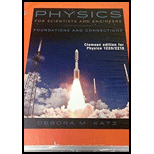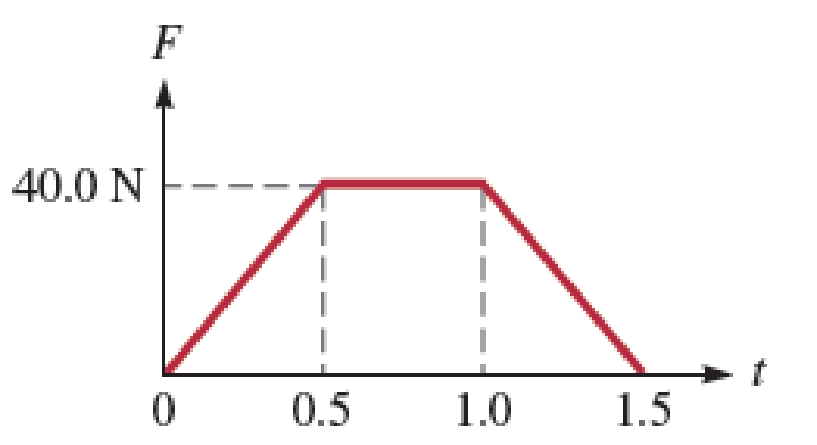
Physics for Scientists and Engineers: Foundations and Connections
15th Edition
ISBN: 9781305289963
Author: Debora M. Katz
Publisher: Cengage Custom Learning
expand_more
expand_more
format_list_bulleted
Textbook Question
Chapter 11, Problem 59PQ
An object of mass m = 4.00 kg that is moving with a speed of 10.0 m/s collides head-on with another object, and the collision lasts 1.50 s. A graph showing the magnitude of the force during the collision versus time is shown in Figure P11.59, where the force is exerted in the direction opposite the initial velocity. Find the speed of the 4.00-kg mass after collision.

FIGURE P11.59
Expert Solution & Answer
Trending nowThis is a popular solution!

Students have asked these similar questions
Example
Two charges, one with +10 μC of charge, and
another with - 7.0 μC of charge are placed in
line with each other and held at a fixed distance
of 0.45 m. Where can you put a 3rd charge of +5
μC, so that the net force on the 3rd charge is
zero?
*
Coulomb's Law Example
Three charges are positioned as seen below. Charge
1 is +2.0 μC and charge 2 is +8.0μC, and charge 3 is -
6.0MC.
What is the magnitude and the direction of the force
on charge 2 due to charges 1 and 3?
93
kq92
F
==
2
r13 = 0.090m
91
r12 = 0.12m
92
Coulomb's Constant: k = 8.99x10+9 Nm²/C²
✓
Make sure to draw a Free Body Diagram as well
Chapter 11 Solutions
Physics for Scientists and Engineers: Foundations and Connections
Ch. 11.1 - Forensic Science Forensic science is the...Ch. 11.2 - Why does a coach instruct a gymnast to bend her...Ch. 11.3 - When two objects collide, the impulse exerted on...Ch. 11.3 - Prob. 11.4CECh. 11.5 - If a spacecraft is headed for the outer solar...Ch. 11.6 - The cue ball hits the eight-ball in a game of pool...Ch. 11 - When a spacecraft collides with a planet, it is...Ch. 11 - When a person feels that he is about to fall, he...Ch. 11 - A tall man walking at 1.25 m/s accidentally bumps...Ch. 11 - Prob. 4PQ
Ch. 11 - A basketball of mass m = 625 g rolls off the hoops...Ch. 11 - Prob. 6PQCh. 11 - Sven hits a baseball (m = 0.15 kg). He applies an...Ch. 11 - Prob. 8PQCh. 11 - Prob. 9PQCh. 11 - In a laboratory, a cart collides with a wall and...Ch. 11 - Prob. 11PQCh. 11 - A Show that Equation 11.4 (the impulsemomentum...Ch. 11 - A crate of mass M is initially at rest on a level,...Ch. 11 - Prob. 14PQCh. 11 - Two pucks in a laboratory are placed on an air...Ch. 11 - A truck collides with a small, empty parked car....Ch. 11 - Prob. 17PQCh. 11 - Prob. 18PQCh. 11 - A skater of mass m standing on ice throws a stone...Ch. 11 - A skater of mass 45.0 kg standing on ice throws a...Ch. 11 - Prob. 21PQCh. 11 - In a laboratory experiment, 1 a block of mass M is...Ch. 11 - Ezra (m = 25.0 kg) has a tire swing and wants to...Ch. 11 - A suspicious physics student watches a stunt...Ch. 11 - A 2.45-kg ball is shot into a 0.450-kg box that is...Ch. 11 - Prob. 26PQCh. 11 - Prob. 27PQCh. 11 - Prob. 28PQCh. 11 - A dart of mass m is fired at and sticks into a...Ch. 11 - A dart of mass m = 10.0 g is fired at and sticks...Ch. 11 - A bullet of mass m = 8.00 g is fired into and...Ch. 11 - Prob. 32PQCh. 11 - A bullet of mass m is fired into a ballistic...Ch. 11 - Prob. 34PQCh. 11 - One object (m1 = 0.200 kg) is moving to the right...Ch. 11 - Prob. 36PQCh. 11 - Prob. 37PQCh. 11 - Prob. 38PQCh. 11 - Two objects collide head-on (Fig. P11.39). The...Ch. 11 - Initially, ball 1 rests on an incline of height h,...Ch. 11 - Initially, ball 1 rests on an incline of height h,...Ch. 11 - In an attempt to produce exotic new particles, a...Ch. 11 - Pendulum bob 1 has mass m1. It is displaced to...Ch. 11 - Prob. 44PQCh. 11 - Prob. 45PQCh. 11 - Prob. 46PQCh. 11 - Prob. 47PQCh. 11 - Prob. 48PQCh. 11 - Two skateboarders, with masses m1 = 75.0 kg and m2...Ch. 11 - In a laboratory experiment, an electron with a...Ch. 11 - In Figure P11.51, a cue ball is shot toward the...Ch. 11 - A proton with an initial speed of 2.00 108 m/s in...Ch. 11 - A football player of mass 95 kg is running at a...Ch. 11 - Two bumper cars at the county fair are sliding...Ch. 11 - Two bumper cars at the county fair are sliding...Ch. 11 - Prob. 56PQCh. 11 - N A bomb explodes into three pieces A, B, and C of...Ch. 11 - Prob. 58PQCh. 11 - An object of mass m = 4.00 kg that is moving with...Ch. 11 - A wooden block of mass M is initially at rest at...Ch. 11 - Prob. 61PQCh. 11 - Prob. 62PQCh. 11 - In an experiment designed to determine the...Ch. 11 - From what might be a possible scene in the comic...Ch. 11 - Prob. 65PQCh. 11 - Two pucks in a laboratory are placed on an air...Ch. 11 - Assume the pucks in Figure P11.66 stick together...Ch. 11 - Prob. 68PQCh. 11 - Prob. 69PQCh. 11 - A ball of mass 50.0 g is dropped from a height of...Ch. 11 - Prob. 71PQCh. 11 - A pendulum consists of a wooden bob of mass M...Ch. 11 - Three runaway train cars are moving on a...Ch. 11 - Prob. 74PQCh. 11 - Rutherford fired a beam of alpha particles (helium...Ch. 11 - Prob. 76PQCh. 11 - Prob. 77PQCh. 11 - February 3, 2009, was a very snowy day along...Ch. 11 - A cart filled with sand rolls at a speed of 1.0...Ch. 11 - Prob. 80PQCh. 11 - Prob. 81PQCh. 11 - Prob. 82PQCh. 11 - Prob. 83PQCh. 11 - Prob. 84PQ
Knowledge Booster
Learn more about
Need a deep-dive on the concept behind this application? Look no further. Learn more about this topic, physics and related others by exploring similar questions and additional content below.Similar questions
- RT = 4.7E-30 18V IT = 2.3E-3A+ 12 38Ω ли 56Ω ли r5 27Ω ли r3 28Ω r4 > 75Ω r6 600 0.343V 75.8A Now figure out how much current in going through the r4 resistor. |4 = unit And then use that current to find the voltage drop across the r resistor. V4 = unitarrow_forward7 Find the volume inside the cone z² = x²+y², above the (x, y) plane, and between the spheres x²+y²+z² = 1 and x² + y²+z² = 4. Hint: use spherical polar coordinates.arrow_forwardганм Two long, straight wires are oriented perpendicular to the page, as shown in the figure(Figure 1). The current in one wire is I₁ = 3.0 A, pointing into the page, and the current in the other wire is 12 4.0 A, pointing out of the page. = Find the magnitude and direction of the net magnetic field at point P. Express your answer using two significant figures. VO ΜΕ ΑΣΦ ? Figure P 5.0 cm 5.0 cm ₁ = 3.0 A 12 = 4.0 A B: μΤ You have already submitted this answer. Enter a new answer. No credit lost. Try again. Submit Previous Answers Request Answer 1 of 1 Part B X Express your answer using two significant figures. ΜΕ ΑΣΦ 0 = 0 ? below the dashed line to the right P You have already submitted this answer. Enter a new answer. No credit lost. Try again.arrow_forward
arrow_back_ios
SEE MORE QUESTIONS
arrow_forward_ios
Recommended textbooks for you
 Physics for Scientists and Engineers: Foundations...PhysicsISBN:9781133939146Author:Katz, Debora M.Publisher:Cengage Learning
Physics for Scientists and Engineers: Foundations...PhysicsISBN:9781133939146Author:Katz, Debora M.Publisher:Cengage Learning Principles of Physics: A Calculus-Based TextPhysicsISBN:9781133104261Author:Raymond A. Serway, John W. JewettPublisher:Cengage Learning
Principles of Physics: A Calculus-Based TextPhysicsISBN:9781133104261Author:Raymond A. Serway, John W. JewettPublisher:Cengage Learning University Physics Volume 1PhysicsISBN:9781938168277Author:William Moebs, Samuel J. Ling, Jeff SannyPublisher:OpenStax - Rice University
University Physics Volume 1PhysicsISBN:9781938168277Author:William Moebs, Samuel J. Ling, Jeff SannyPublisher:OpenStax - Rice University Glencoe Physics: Principles and Problems, Student...PhysicsISBN:9780078807213Author:Paul W. ZitzewitzPublisher:Glencoe/McGraw-Hill
Glencoe Physics: Principles and Problems, Student...PhysicsISBN:9780078807213Author:Paul W. ZitzewitzPublisher:Glencoe/McGraw-Hill Physics for Scientists and Engineers with Modern ...PhysicsISBN:9781337553292Author:Raymond A. Serway, John W. JewettPublisher:Cengage Learning
Physics for Scientists and Engineers with Modern ...PhysicsISBN:9781337553292Author:Raymond A. Serway, John W. JewettPublisher:Cengage Learning Physics for Scientists and EngineersPhysicsISBN:9781337553278Author:Raymond A. Serway, John W. JewettPublisher:Cengage Learning
Physics for Scientists and EngineersPhysicsISBN:9781337553278Author:Raymond A. Serway, John W. JewettPublisher:Cengage Learning

Physics for Scientists and Engineers: Foundations...
Physics
ISBN:9781133939146
Author:Katz, Debora M.
Publisher:Cengage Learning

Principles of Physics: A Calculus-Based Text
Physics
ISBN:9781133104261
Author:Raymond A. Serway, John W. Jewett
Publisher:Cengage Learning

University Physics Volume 1
Physics
ISBN:9781938168277
Author:William Moebs, Samuel J. Ling, Jeff Sanny
Publisher:OpenStax - Rice University

Glencoe Physics: Principles and Problems, Student...
Physics
ISBN:9780078807213
Author:Paul W. Zitzewitz
Publisher:Glencoe/McGraw-Hill

Physics for Scientists and Engineers with Modern ...
Physics
ISBN:9781337553292
Author:Raymond A. Serway, John W. Jewett
Publisher:Cengage Learning

Physics for Scientists and Engineers
Physics
ISBN:9781337553278
Author:Raymond A. Serway, John W. Jewett
Publisher:Cengage Learning
Impulse Derivation and Demonstration; Author: Flipping Physics;https://www.youtube.com/watch?v=9rwkTnTOB0s;License: Standard YouTube License, CC-BY